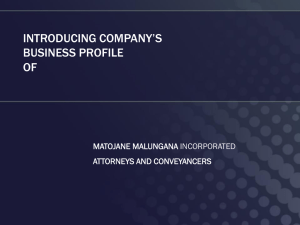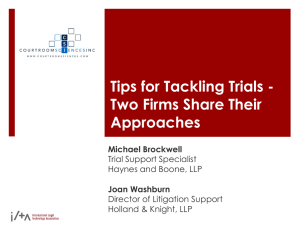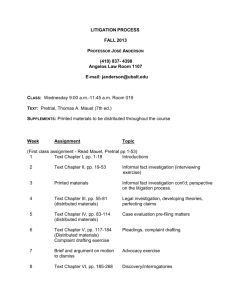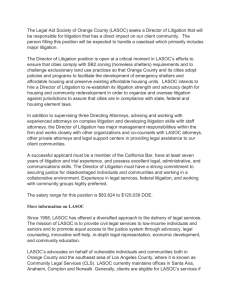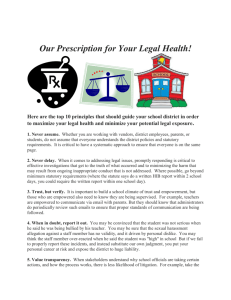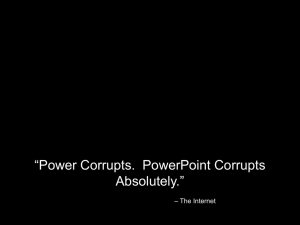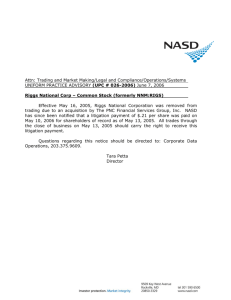Caseload Highlights - Court Statistics Project
advertisement
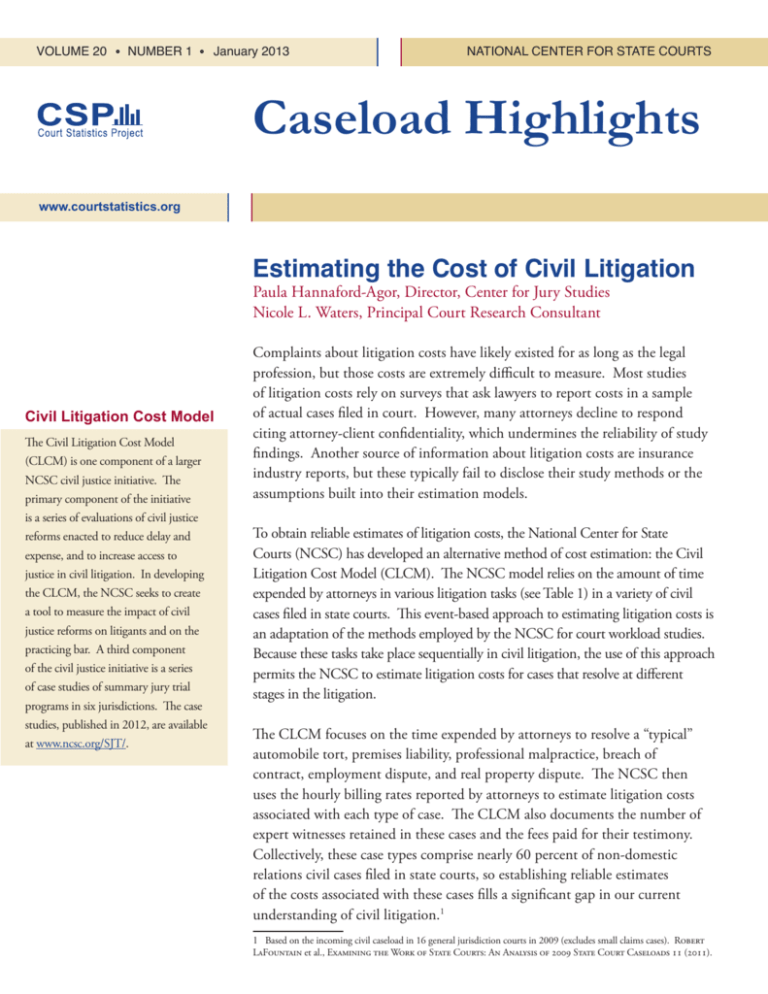
VOLUME 20 NUMBER 1 January 2013 NATIONAL CENTER FOR STATE COURTS Caseload Highlights www.courtstatistics.org Estimating the Cost of Civil Litigation Paula Hannaford-Agor, Director, Center for Jury Studies Nicole L. Waters, Principal Court Research Consultant Civil Litigation Cost Model The Civil Litigation Cost Model (CLCM) is one component of a larger NCSC civil justice initiative. The primary component of the initiative is a series of evaluations of civil justice reforms enacted to reduce delay and expense, and to increase access to justice in civil litigation. In developing the CLCM, the NCSC seeks to create a tool to measure the impact of civil justice reforms on litigants and on the practicing bar. A third component of the civil justice initiative is a series of case studies of summary jury trial programs in six jurisdictions. The case studies, published in 2012, are available at www.ncsc.org/SJT/. Complaints about litigation costs have likely existed for as long as the legal profession, but those costs are extremely difficult to measure. Most studies of litigation costs rely on surveys that ask lawyers to report costs in a sample of actual cases filed in court. However, many attorneys decline to respond citing attorney-client confidentiality, which undermines the reliability of study findings. Another source of information about litigation costs are insurance industry reports, but these typically fail to disclose their study methods or the assumptions built into their estimation models. To obtain reliable estimates of litigation costs, the National Center for State Courts (NCSC) has developed an alternative method of cost estimation: the Civil Litigation Cost Model (CLCM). The NCSC model relies on the amount of time expended by attorneys in various litigation tasks (see Table 1) in a variety of civil cases filed in state courts. This event-based approach to estimating litigation costs is an adaptation of the methods employed by the NCSC for court workload studies. Because these tasks take place sequentially in civil litigation, the use of this approach permits the NCSC to estimate litigation costs for cases that resolve at different stages in the litigation. The CLCM focuses on the time expended by attorneys to resolve a “typical” automobile tort, premises liability, professional malpractice, breach of contract, employment dispute, and real property dispute. The NCSC then uses the hourly billing rates reported by attorneys to estimate litigation costs associated with each type of case. The CLCM also documents the number of expert witnesses retained in these cases and the fees paid for their testimony. Collectively, these case types comprise nearly 60 percent of non-domestic relations civil cases filed in state courts, so establishing reliable estimates of the costs associated with these cases fills a significant gap in our current understanding of civil litigation.1 1 Based on the incoming civil caseload in 16 general jurisdiction courts in 2009 (excludes small claims cases). Robert LaFountain et al., Examining the Work of State Courts: An Analysis of 2009 State Court Caseloads 11 (2011). www.courtstatistics.org Table 1: Litigation Tasks Case Initiation Conduct client intake; initial fact investigation; legal research; draft complaint/answer, crossclaim, counterclaim or third-party claim; motion to dismiss on procedural grounds; defenses to procedural motions; meet and confer regarding case scheduling and discovery. Discovery Draft and file mandatory disclosures; draft/answer interrogatories; respond to requests for production of documents; identify and consult with experts; review expert reports; identify and interview non-expert witnesses; depose opponent’s witnesses; prepare for and attend opponent’s depositions; resolve electronically stored information issues; review discovery/ case assessment; resolve discovery disputes. Settlement Attend mandatory ADR; settlement negotiations; settlement conferences; draft settlement agreement; draft and file motion to dismiss. Pretrial Motions Legal research; draft motions in limine; draft motions for summary judgment; answer opponent’s motions; prepare for motion hearings; argue motions. Trial Legal research; prepare witnesses and experts; meet with co-counsel (trial team); prepare for voir dire; motion to sequester; prepare opening and closing statements; prepare for direct (and cross) examination; prepare jury instructions; propose findings of fact and conclusions of law; propose orders; conduct trial. Post-Disposition Conduct post-disposition settlement negotiations; draft motions for rehearing, JNOV, additur, remittitur, enforce judgment; any appeal activity. The CLCM explicitly recognizes that many factors affect the amount of attorney time expended on different litigation tasks. Among the more obvious factors are case complexity, client expectations, and the working relationship with opposing counsel. In addition, law firms have different internal staffing and training priorities, which affects whether certain tasks are undertaken by senior-level attorneys or delegated to more junior attorneys or even paralegal staff. Senior-level attorneys are more experienced and may be able to complete tasks more efficiently than their junior-level colleagues. On the other hand, work performed by senior-level attorneys is invariably billed at higher rates. In the CLCM survey, respondents were asked to estimate the amount of time needed to complete legal tasks for each case type assuming that the case was appropriately staffed in the context of each law firm. For example, in a multi-attorney law firm, senior attorneys have a largely supervisory role over the work of more junior attorneys and paralegal staff in case preparation, but take a more direct role in dispositive litigation tasks such as settlement negotiations and trial. To control for natural variation in case-level time expenditures and billing rates, the CLCM examines quartiles from national estimates to identify the mid-range of “typical” cases. A working assumption is that exceptionally easy and exceptionally difficult cases will ultimately balance each other out. Two caveats about the CLCM are necessary. First, the NCSC staff that developed the CLCM were surprised by the difficulty that most attorneys, even highly experienced attorneys, encountered when they were asked to visualize a “typical” automobile tort or other type of civil case. While state courts have become more acclimated to employing performance measures to assess both quantitative and qualitative aspects of court operations, it appears that most segments of the practicing civil bar approach legal representation on a case-by-case basis. Consequently, many attorneys who participated in the project found it challenging to estimate the number of hours involved in drafting a complaint, preparing for and conducting depositions, or trying a “typical” case even when case scenarios included generalized “facts” to help illustrate case parameters. 2 The second issue involved obtaining information about billable hourly rates for senior-level attorneys, junior-level attorneys and paralegal staff given the wide variety of billing practices in the civil bar. Many firms employ separate billing rates for in-court versus out-of-court work. Plaintiff lawyers who work primarily or exclusively under contingency fee agreements often had no basis on which to estimate an hourly rate comparable to the traditional hourly billable rate. In other law firms, billing may vary based on the client relationship with some work performed on a retainer basis, some work performed at a negotiated discount rate for high volume clients, and some work performed on a pro bono basis. Presumably the financial business model employed by each law firm takes these variations into account when setting compensation for its professional employees such that overall receipts are sufficient to cover routine direct and overhead expenses regardless of the billing arrangements for individual clients. The ABOTA Survey The NCSC pilot tested the CLCM methodology with a sample of experienced civil litigation attorneys in New Hampshire in the fall of 2011. In a focus group setting, those attorneys confirmed that the estimates derived from the CLCM were reasonable based on their experience with civil cases filed in the New Hampshire Superior Courts. After making some minor adjustments based on feedback from the working group of New Hampshire attorneys and NCSC colleagues, the NCSC used the CLCM to undertake a national study in cooperation with the American Board of Trial Advocates (ABOTA). The cooperation of ABOTA offered the NCSC an ideal sample from which to collect data for the CLCM. Founded in 1958, ABOTA is a national organization comprised of experienced attorneys representing both plaintiffs and defendants in civil litigation. Its mission is to defend the American civil justice system, especially the Seventh Amendment right to trial by jury. ABOTA has approximately 6,500 members who are organized into 96 state and local chapters in 49 states and the District of Columbia. Qualifications for membership are quite high. Applicants for the lowest tier of membership (Member) must be nominated by an existing ABOTA member, have completed a minimum of 10 jury trials to verdict as lead counsel, and are expected to achieve the qualifications for Associate level membership within a reasonable period of time. Qualifications for more senior membership tiers are described in Table 2. In an age in which many lawyers will not try even one case to a jury over their entire careers, the qualifications for ABOTA membership ensure that its membership reflects the most highly experienced civil trial attorneys, and presumably the most knowledgeable in the country about the amount of effort involved in litigating these cases. The CLCM survey was disseminated online to the entire ABOTA membership from July 31 through August 31, 2012. During that time, 202 ABOTA members submitted complete survey responses and an additional 110 ABOTA members submitted partial survey responses with time estimates for one or more of the practice areas. Although respondents practice law in 43 states, over half practiced in California, Texas, or Florida (three of the largest, most active ABOTA statewide chapters, representing 26% of the U.S. population). More than one-third of the respondents were Advocate or Diplomate-level members, the two most highly experienced levels of ABOTA. 3 www.courtstatistics.org In terms of law firm characteristics, half of the respondents work in modest size firms (2 to 10 attorneys) and 13 percent were solo practitioners. One-third work in somewhat larger firms (19% in 11 to 25-lawyer firms, 15% in 26 to 100-lawyer firms), and only 3 percent in very large law firms (more than 100 lawyers). The vast majority (82%) of respondents work in general civil practice firms in which lawyers routinely take cases in at least 4 of the practice areas covered in the survey. Thirty-one respondents practice in boutique firms concentrating on a single practice area (21 in professional malpractice; 10 in automobile tort). The 312 respondents collectively reflect the professional characteristics of ABOTA’s members. Table 2: ABOTA Membership Levels, Qualifications, and Respondents to the CLCM Survey Minimum Years Experience Minimum Number of Civil Jury Trials to Verdict Diplomate 12 100 30 Associate 5 20 152 49% 4 1% Level Advocate Member Other** Total 8 n/a 50 10* Based on previous ABOTA membership achieved ABOTA Respondents Number Percent 82 44 312 10% 26% 14% * Member level requires a minimum of 10 cases tried to verdict as lead counsel, but the cases do not have to be exclusively civil cases. ** Other includes judges, public sector attorneys, and emeritus members. Attorney Time and Costs in Automobile Tort Cases To illustrate the CLCM methodology, Table 3 presents the quartile breakdown of attorney and paralegal time, prevailing billable rates, and expert witness fees in a typical automobile tort case. At the 25th percentile, senior and junior attorneys each spend 2 hours on case initiation tasks while paralegal staff spend one hour for a total of 5 hours of professional time. The total amount of professional time engaged in case initiation increases to 12.5 hours at the 50th percentile, or median (4.5 and 5 hours, respectively, by senior and junior-level attorneys and 3 hours by paralegal staff), and to 30 hours at the 75th percentile (10 hours each by senior-level attorneys, junior-level attorneys, and paralegal staff). Depending on how far through the litigation process the case progresses before it is ultimately resolved, ABOTA respondents report that typical automobile tort cases require up to 95.6 hours of professional time at the 25th percentile, 196 hours at the 50th percentile, and up to 360.8 hours at the 75th percentile. Billable rates ranged from $200 to $375 per hour for senior attorneys, $150 to $250 per hour for junior attorneys, and $80 to $110 per hour for paralegal support. If the case progressed to the point of retaining an expert witness, which generally takes place during discovery, each side typically hires one expert witness at the 25th and 50th percentile, and two expert witnesses at the 75th percentile at a cost of $2,500 to $7,500 per expert. 4 Table 3: Hours Expended by Attorneys, Paralegals and Expert Witnesses to Complete Litigation Tasks in Automobile Tort Cases* Percentile Senior Attorney 25th 50th 75th Discovery 5.0 12.0 25.0 6.8 20.0 3.0 6.0 15.0 4.0 10.0 Case Initiation 2.0 Settlement 5.0 Pre-trial Trial 4.5 8.0 10.0 10.0 Junior Attorney 25 50th 75th th 2.0 2.0 25.0 40.0 65.0 15.0 Post-disposition 2.8 5.0 10.0 3.5 Subtotal of Time 42.8 75.5 135.0 x $200 $275 $20,763 Prevailing Hourly Rates Billable Costs $ 8,550 Number Billable Costs 10.0 5.0 10.0 30.0 30.0 20.0 75th 5.0 10.0 20.0 2.0 4.0 10.0 1.0 0.5 3.0 2.0 10.0 5.0 50.0 10.0 20.0 38.8 8.0 15.5 1.0 3.5 6.5 33.3 78.0 135.5 19.5 42.5 90.3 $375 $150 $175 $250 $ 80 $ 90 $110 $50,625 $ 4,988 $13,650 $33,875 $ 1,560 $ 3,825 $ 9,928 Expert Witnesses 25th 50th 75th Percentile Prevailing Fees 5.0 25 Paralegal 50th th x 1 1 2 $ 2,500 $ 5,000 $ 7,500 $ 2,500 $ 5,000 $15,000 *Based on: 255 experienced attorneys As Table 3 shows, the range of professional time expended on the various litigation tasks for a typical automobile tort case is surprisingly large. The ratio of time expended from the 25th percentile to the 50th percentile to the 75th percentile appears remarkably stable across each litigation task and for each type of legal professional. The hours expended at the 50th percentile are consistently 2 to 2.5 times more than the hours expended at the 25th percentile; at the 75th percentile the number of hours is approximately 4 times more than those at the 25th percentile. The ratios are somewhat larger for junior attorneys and paralegals compared to senior attorneys, but the general pattern of doubling the amount of time at the 50th percentile and doubling it again at the 75th percentile remains the same. Applying the hourly billable rates to the time estimates in Table 3 provides estimates of the costs associated with a typical automobile tort case. See Figure 1. Cases that resolve shortly after case initiation range from less than $1,000 at the 25th percentile to $7,350 at the 75th percentile per side for attorney fees. As the case progresses, those costs continue to accumulate. A case that settles after discovery is complete through formal settlement negotiations or ADR will range from $5,000 to $36,000 in attorney fees. If the case goes to trial, the total costs including expert witness fees can range from $18,000 to $109,000 per side.2 Based on these estimates, it becomes easy to see how litigation costs might affect a litigant’s access to the civil justice system. Few litigants would be willing to risk incurring such costs unless the expected return – damages awarded for plaintiffs or damages avoided for defendants – greatly exceed those costs. Most litigants would prefer to settle the case well before costs rose to that level. Even attorneys who ordinarily represent plaintiffs under a contingency fee agreement would naturally evaluate the case based on the likelihood that the resulting fee from the settlement value of the case will exceed the expected investment of attorney time and law firm resources before accepting the case. 2 Expert witnesses are identified and retained during discovery, but fee agreements generally specify a certain amount or percentage of the fee for drafting a report, participating in a deposition, and testifying at trial. The expert witness expenses reflected in Figure 1 allocate 20 percent of the total expert witness fees to the discovery stage for preparation of an expert witness report and deposition, and 80 percent to the trial stage for expert testimony at trial. This split is based on reports by trial attorneys of the impact of restrictions on live expert witness testimony in summary jury trial programs. See Short, Summary & Expedited: The Evolution of Summary Jury Trials (NCSC 2012). 5 www.courtstatistics.org Figure 1: Attorney and Expert Witness Fees by Litigation Stage for Automobile Tort Cases 75th Percentile = $109,428 in thousands $60 50th Percentile = $43,238 $40 25th Percentile = $17,598 $20 Total Costs Trial PostDisposition Pretrial Settlement Discovery Initiate Total Costs Trial PostDisposition Pretrial Settlement Discovery Initiate Total Costs Trial PostDisposition Pretrial Settlement Discovery Initiate $0 Other Types of Civil Cases In addition to automobile tort cases, the NCSC modeled litigation time and costs for professional malpractice, premises liability, breach of contract, employment dispute, and real estate dispute cases. Detailed tables showing results for each case type are available at www.ncsc.org/clcm. Table 4 shows the proportion of the total attorney hours expended on each stage of litigation for these case types at the 50th percentile as well as the total number of attorney hours that might be expended in a case that progressed all way through trial and post-disposition proceedings. Across virtually every stage of litigation, professional malpractice cases expend the most amount of legal time and automobile tort cases expend the least amount of time. Table 4: Proportion of Litigation per Stage (Total Median Hours) Litigation Task Initiate Auto 6% Premises Liability 8% Real Property 12% 10% 8% 7% Discovery 21% 19% 22% Pretrial 10% 14% 8% 8% Settlement 8% Trial 46% Total Attorney Hours (Median) 196 Post-disposition 6 9% Contract Employment Malpractice 11% 8% 24% 21% 25% 15% 14% 15% 11% 9% 8% 7% 41% 34% 218 284 39% 367 7% 6% 39% 42% 374 472 7% For all case types, a trial is the single most time-intensive stage of litigation, encompassing between one-third and one-half of total litigation time in cases that progress all the way through trial. Discovery is the second most timeintensive stage, encompassing between one-fifth and one-quarter of total attorney hours. The remaining litigation stages each required less than 15 percent of total attorney time. Current civil justice reform efforts often focus on reducing the amount of time expended on trial and discovery tasks during litigation. To be effective, these efforts must not only decrease the amount of time involved in these litigation stages, but do so without shifting that time to other litigation tasks. Successful civil justice reform along these lines would not only reduce the litigation costs associated with each case type (see Figure 2), but may also reduce the time to disposition, providing litigants with speedier, as well as less expensive, justice. Figure 2: Median Costs of Litigation by Case Type Malpractice = $122k Employment = $88k in thousands $75 $60 $45 Contract = $91k Real Property = $66k Premises Liability = $54k Automobile = $43k $30 $15 Initiate Discovery Settlement Pretrial Trial Post-Disposition Total Costs Initiate Discovery Settlement Pretrial Trial Post-Disposition Total Costs Initiate Discovery Settlement Pretrial Trial Post-Disposition Total Costs Initiate Discovery Settlement Pretrial Trial Post-Disposition Total Costs Initiate Discovery Settlement Pretrial Trial Post-Disposition Total Costs Initiate Discovery Settlement Pretrial Trial Post-Disposition Total Costs $0 Future uses of the CLCM The NCSC plans to conduct further testing with experienced lawyers to confirm the reliability of the cost estimates and to further differentiate factors that affect the model. The NCSC will also continue surveying highly experienced attorneys to adjust these national estimates for state and local jurisdictions. The results of these highly focused surveys will provide bench and bar leaders with tools (1) to conduct local assessments; (2) to focus civil justice reform efforts on litigation stages that require more attorney time ; and (3) to assess the impact of those reforms on access to justice. 7 PRESIDENT Mary Campbell McQueen PRESIDENT VICEMary PRESIDENT RESEARCH DIVISION Campbell McQueen Thomas M. Clarke VICE PRESIDENT, RESEARCH DIVISION Thomas M. Clarke COURT STATISTICS PROJECT STAFF National Center for State Courts 300 Newport Avenue Williamsburg, Va 23185-4147 DIRECTOR COURT STATISTICS PROJECT STAFF R DIRECTOR SENIOR COURT RESEARCH ANALYSTS Richard Y. Schauffler Robert C. LaFountain SENIOR COURT RESEARCH ANALYSTS Shauna M. Strickland Robert C. LaFountain COURT RESEARCH ANALYSTS Shauna M. Strickland Chantal G. Bromage Sarah A. A. Holt Gibson Kathryn Ashley N. Mason PROGRAM SPECIALIST William E. Raftery COURT RESEARCH ANALYST Brenda G. Otto PROGRAM SPECIALIST INFORMATION DESIGN Brenda G. Otto Neal B. Kauder, INFORMATION Inc. DESIGN VisualResearch, Neal B. Kauder, VisualResearch, Inc. This project was supported by Grant No. 2011-BJ-CX-K062 awarded of HEREIN Justice POINTSby OF the VIEWBureau EXPRESSED ARE Statistics, THOSE OF THE AUTHORS AND Office of Justice DO NOT NECESSARILY REPRESENT THE Programs, U.S. Department of OFFICIAL POSITION OR POLICIES OF Justice. Points of view in this THE BUREAU OF JUSTICE STATISTICS document are those of the author OR THE OFFICE OF JUSTICE PROGRAMS. and do not necessarily represent the official position or policies of the U.S. Department of Justice. www.courtstatistics.org RESEARCH DIVISION 800.616.6109 Court Statistics Project Since 1975, the Court Statistics Project (CSP) has provided a comprehensive analysis of the work of state courts by gathering caseload data and creating meaningful comparisons for identifying trends, comparing caseloads, and highlighting policy issues. The CSP is supported by the Bureau of Justice Statistics and obtains policy direction from the Conference of State Court Administrators. A complete annual analysis of the work of the state trial and appellate courts will be found in Examining the Work: An Analysis of 2010 State Court Caseloads. 8 Visit the CSP Website at www.courtstatisticts.org Nonprofit U.S Postage PAID Richmond, Va Permit No. 9
